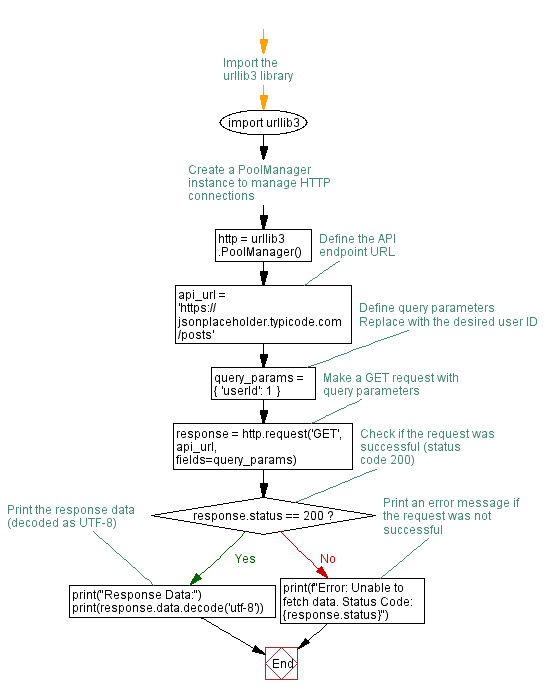Python HTTP GET Request with Query parameters example
Write a Python program that uses query parameters in a GET request to filter or limit the results from an API.
Sample Solution:
Python Code :
# Import the urllib3 library
import urllib3
# Create a PoolManager instance to manage HTTP connections
http = urllib3.PoolManager()
# Define the API endpoint URL
api_url = 'https://jsonplaceholder.typicode.com/posts'
# Define query parameters
query_params = {
'userId': 1 # Replace with the desired user ID
}
# Make a GET request with query parameters
response = http.request('GET', api_url, fields=query_params)
# Check if the request was successful (status code 200)
if response.status == 200:
# Print the response data (decoded as UTF-8)
print("Response Data:")
print(response.data.decode('utf-8'))
else:
# Print an error message if the request was not successful
print(f"Error: Unable to fetch data. Status Code: {response.status}")
Sample Output:
Response Data:
[
{
"userId": 1,
"id": 1,
"title": "sunt aut facere repellat provident occaecati excepturi optio reprehenderit",
"body": "quia et suscipit\nsuscipit recusandae consequuntur expedita et cum\nreprehenderit molestiae ut ut quas totam\nnostrum rerum est autem sunt rem eveniet architecto"
},
{
"userId": 1,
"id": 2,
"title": "qui est esse",
"body": "est rerum tempore vitae\nsequi sint nihil reprehenderit dolor beatae ea dolores neque\nfugiat blanditiis voluptate porro vel nihil molestiae ut reiciendis\nqui aperiam non debitis possimus qui neque nisi nulla"
},
{
"userId": 1,
"id": 3,
"title": "ea molestias quasi exercitationem repellat qui ipsa sit aut",
"body": "et iusto sed quo iure\nvoluptatem occaecati omnis eligendi aut ad\nvoluptatem doloribus vel accusantium quis pariatur\nmolestiae porro eius odio et labore et velit aut"
},
{
"userId": 1,
"id": 4,
"title": "eum et est occaecati",
"body": "ullam et saepe reiciendis voluptatem adipisci\nsit amet autem assumenda provident rerum culpa\nquis hic commodi nesciunt rem tenetur doloremque ipsam iure\nquis sunt voluptatem rerum illo velit"
},
{
"userId": 1,
"id": 5,
"title": "nesciunt quas odio",
"body": "repudiandae veniam quaerat sunt sed\nalias aut fugiat sit autem sed est\nvoluptatem omnis possimus esse voluptatibus quis\nest aut tenetur dolor neque"
},
{
"userId": 1,
"id": 6,
"title": "dolorem eum magni eos aperiam quia",
"body": "ut aspernatur corporis harum nihil quis provident sequi\nmollitia nobis aliquid molestiae\nperspiciatis et ea nemo ab reprehenderit accusantium quas\nvoluptate dolores velit et doloremque molestiae"
},
{
"userId": 1,
"id": 7,
"title": "magnam facilis autem",
"body": "dolore placeat quibusdam ea quo vitae\nmagni quis enim qui quis quo nemo aut saepe\nquidem repellat excepturi ut quia\nsunt ut sequi eos ea sed quas"
},
{
"userId": 1,
"id": 8,
"title": "dolorem dolore est ipsam",
"body": "dignissimos aperiam dolorem qui eum\nfacilis quibusdam animi sint suscipit qui sint possimus cum\nquaerat magni maiores excepturi\nipsam ut commodi dolor voluptatum modi aut vitae"
},
{
"userId": 1,
"id": 9,
"title": "nesciunt iure omnis dolorem tempora et accusantium",
"body": "consectetur animi nesciunt iure dolore\nenim quia ad\nveniam autem ut quam aut nobis\net est aut quod aut provident voluptas autem voluptas"
},
{
"userId": 1,
"id": 10,
"title": "optio molestias id quia eum",
"body": "quo et expedita modi cum officia vel magni\ndoloribus qui repudiandae\nvero nisi sit\nquos veniam quod sed accusamus veritatis error"
}
]
Explanation:
Here's a brief explanation of the above Python urllib3 library code:
- Import urllib3:
- Imports the urllib3 library for handling HTTP requests.
- Create a PoolManager instance:
- Initializes a PoolManager instance (http) to manage HTTP connections.
- Define the API endpoint URL:
- Specifies the URL of the API endpoint (api_url) that the script will interact with.
- Define the query parameters:
- Creates a dictionary (query_params) containing parameters for the GET request, such as 'userId' with a value of 1.
- Make a GET request with the query parameters:
- Sends a GET request to the specified API endpoint (api_url) with the defined query parameters using the http.request method. The response is stored in the response variable.
- Check if the request was successful:
- Checks if the HTTP status code of the response is 200, indicating a successful request.
- Print the response data or an error message:
- If the request was successful, print the decoded response data as UTF-8. Otherwise, it prints an error message with the HTTP status code.
Flowchart:

Python Code Editor :
Have another way to solve this solution? Contribute your code (and comments) through Disqus.
Previous: Python HTTP GET Request with custom Headers Example.
Next: Python POST Request to Sample API with Data example.
What is the difficulty level of this exercise?
Test your Programming skills with w3resource's quiz.
